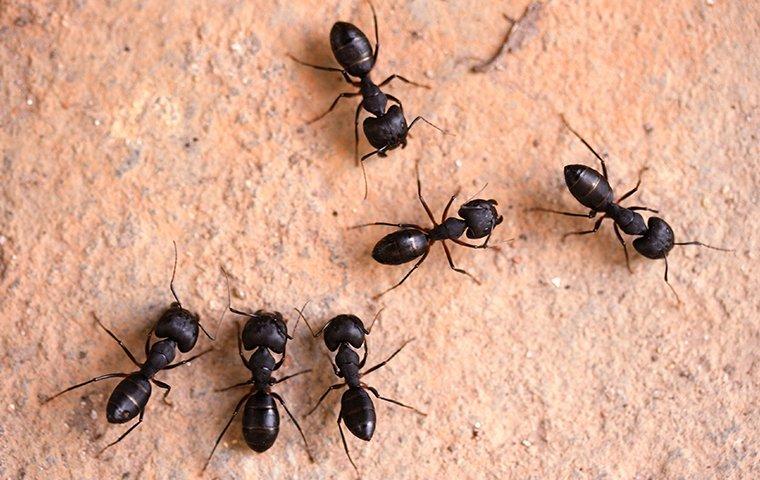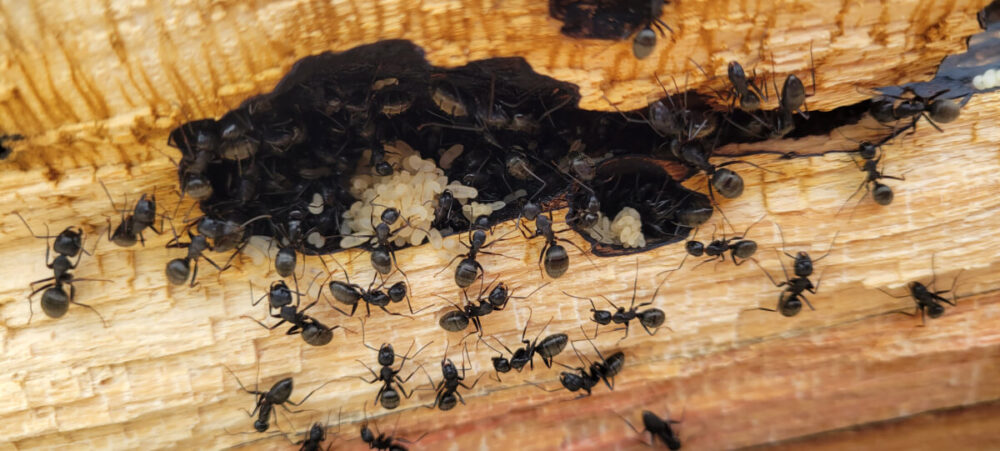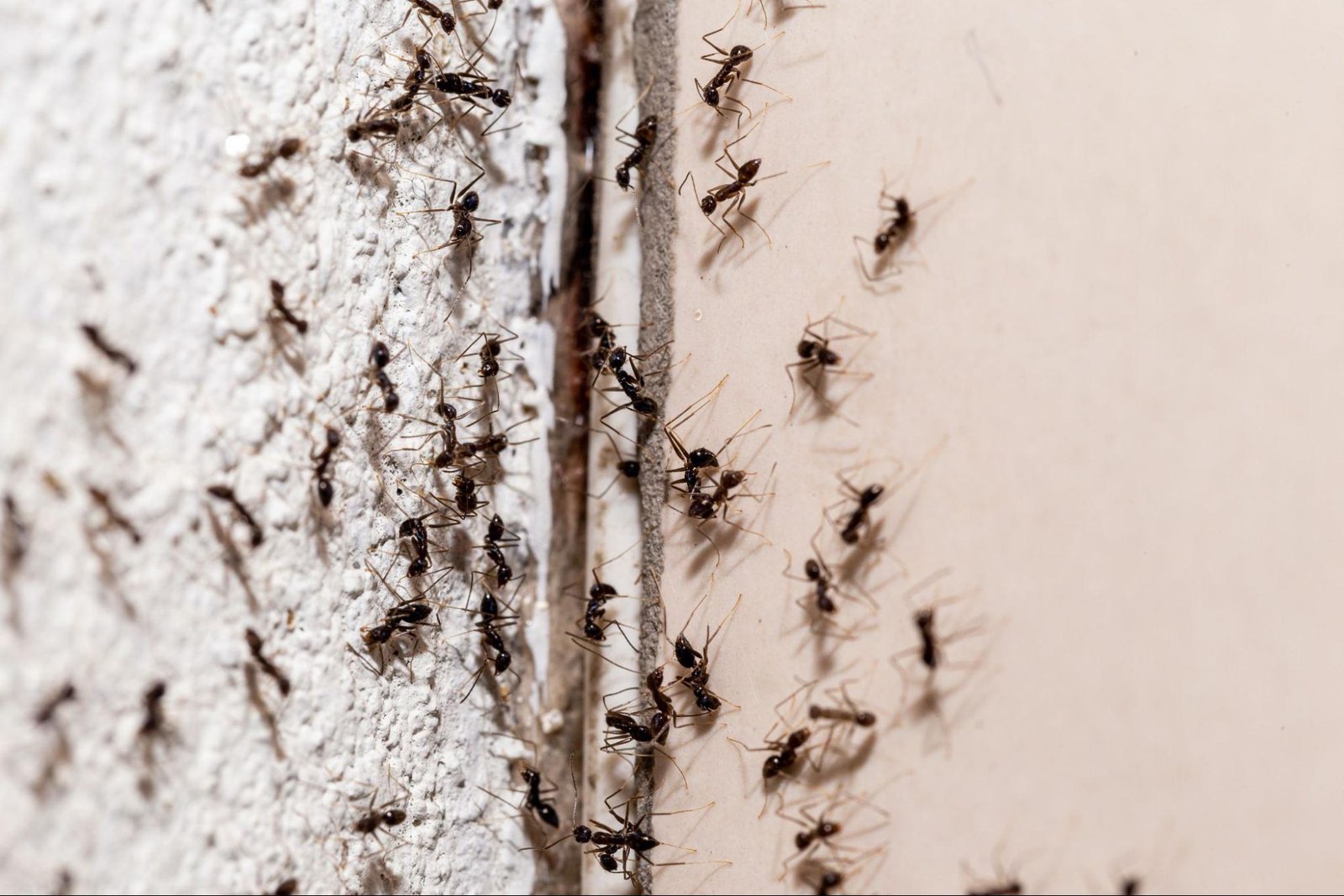To identify ants living in your walls, listen for rustling sounds within the structure or notice consistent ant pathways leading to wall crevices. Seeing piles of sawdust-like material can also indicate their presence.
Discovering ants in your home can be unsettling, especially when they’ve made their way into your walls. These tiny intruders have a knack for finding the smallest of entry points, signaling a potential infestation. Homeowners must stay vigilant, as ants nesting in walls can cause damage over time and lead to further issues.
Keeping an eye out for signs such as faint scratching noises, small piles of debris, or even visible cracks where ants enter and exit is crucial. Quick identification of these symptoms allows for prompt action, helping to protect your home’s integrity and evict these unwanted guests. Regular inspections around the perimeter of your house and immediate attention to ant sightings can make all the difference in preventing these tiny creatures from becoming permanent residents within your walls.

Credit: www.dynastypest.com
Signs Of Ants In Your Walls
Noticing ants skittering across your kitchen counter can be unsettling, but have you ever thought they could be sneaking through your walls? Ants love to set up camp in cozy, out-of-sight places. Your walls might just be the perfect headquarters for their bustling colony. Here’s how to spot the telltale signs that an army of ants is living behind your drywall.
Unusual Noises Behind Walls
One unexpected hint of ants in your walls is sound. When a room falls silent, lean in close to the walls. A soft rustling or a dry crinkling noise might reach your ears. It’s the sound of ants moving, working, or even chewing through wood. Silent moments are the best times to hear these subtle signs.
Visible Ant Trails Along Surfaces
Ants are natural explorers, and they don’t like to travel alone. They leave scent trails to communicate with their fellow workers. Look for consistent lines of ants moving towards tiny crevices or cracks in your walls. These aren’t random explorers; they’re traffic lanes, and they lead straight to the heart of an ant colony.
| Sign | What to Look For |
|---|---|
| Rustling Noises | Soft sounds from within walls, especially at night |
| Ant Trails | Consistent lines of ants across surfaces near walls |
| Crevices and Cracks | Small openings in walls with ants entering and exiting |
- Place your ear against the wall.
- Listen for faint rustling noises.
- Use a flashlight.
- Spot lines of marching ants.
What Attracts Ants Inside Walls
Unseen but busy, ants can be secret tenants in your home’s walls. They search for food, water, and shelter. Understanding what lures ants is key to keeping them out. Let’s dive into why your walls may be the perfect ant hideout.
Moisture And Damp Wood
Ants love moisture – it’s crucial for their survival. Your walls might trap moisture through leaks or poor ventilation. This creates an ideal spot for ants to thrive. Look for:
- Leaky pipes
- Condensation on walls
- Soft, rotting wood that’s easy to nest in
These signs suggest moisture problems, inviting ants to move in.
Cracks And Crevice Entry Points
Tiny cracks can be giant doorways for ants. Inspect your walls for:
- Small openings around windows and doors
- Utility lines entering your home
- Gaps in the foundation or roofing
Sealing these entry points can stop ants from coming in.
Common Ant Species That Invade Homes
Ants march into homes in search of food, water, and shelter. Different species have unique behaviors and impacts. Know the invaders for better ant control strategies.
Carpenter Ants: A Closer Look
Carpenter ants are wood lovers. They carve out galleries in damp or decaying wood to build nests. Look for:
- Fine wood shavings, known as frass
- Soft rustling sounds from walls
- Larger ant bodies with a dark coloration
Bold actions are needed to stop them from damaging the structure of your home. Identify entrance points and seek professional help for eradication.
Pharaoh And Pavement Ants Infestation
Pharaoh ants and pavement ants also wreak havoc indoors. Both favor warm spots and can be tough to evict.
Pharaoh Ants:
- Yellow or light brown
- Prefer kitchens and bathrooms
- Create large colonies
Pavement Ants:
- Dark brown to black
- Nest in soil, follow trails indoors
- Often seen on the ground level
For these persistent pests, bait stations may be effective. Look for professional-grade products or expert extermination services.
The Impact Of An Ant Infestation
Discovering ants living in your walls can be unsettling. These tiny invaders often go unnoticed until their numbers reach the thousands. The presence of ants in your home is more than just a nuisance—it can lead to significant problems.
Potential Structural Damage
Ants tunnel through wood and insulation, compromising the integrity of your home. Over time, the small passageways created by ants can weaken structures and cause costly damage. Here are signs to watch out for:
- Soft, hollow-sounding wood
- Visible wood shavings or sawdust
- Ant trails leading into wall crevices
Regular inspections can catch issues early, preventing extensive and expensive repairs.
Health Risks And Allergies
Ants can affect your health. Some species carry bacteria that contaminate food and surfaces. Allergies can also flare up due to ant presence. Watch for these health concerns:
- Increased asthma symptoms
- Skin irritations or bites
- Allergic reactions to ant venom
A clean, well-maintained home is less attractive to ants and helps protect against these health risks. Call a professional if you suspect an ant infestation.
Inspection Tips For Suspected Ant Infestations
Inspection Tips for Suspected Ant Infestations can spare homeowners the stress of unwanted guests. Ants are tiny but mighty. They sneak into homes, seeking food or shelter. Discovering an ant infestation requires a keen eye. Below are simple steps to unveil these hidden critters.
Identifying Entry Points
Inspect your home’s exterior carefully. Ants are small and can enter through tiny cracks. Follow these easy steps:
- Check window frames and doorways. Openings here are common entry points.
- Examine utility lines and pipes. Ants use these to sneak indoors.
- Look for moisture sources. Wet areas attract ants.
Sealing these entry points can keep ants out.
Checking For Nests And Colonies
Ants build nests in walls, causing unseen trouble. Detect their presence with these tips:
- Listen for rustling sounds in walls, especially at night.
- Tap on walls and listen for a hollow response, which might suggest ant activity.
- Look for frass, which is wood debris ants eject from their nests.
Professional pest control can confirm a nest and eliminate ant colonies.
Diy Solutions To Combat Ant Infestations
Realizing ants have taken up residence in your walls can be unsettling. Fortunate for homeowners, several DIY solutions can help keep these tiny invaders at bay. Roll up your sleeves and prepare to reclaim your home from these unwanted guests!
Natural Repellents And Baits
Ants dislike certain natural substances that can double as effective repellents. DIY baits also help control the problem from within. Below are some solutions to implement:
- Vinegar Solution: Mix equal parts water and vinegar, add a few drops of essential oil, and spray around entry points.
- Diatomaceous Earth: Sprinkle this fine powder in areas where ants are frequent to dehydrate and kill them.
- Borax Bait: Combine borax with sugar to attract and poison the colony.
- Coffee Grounds: Place used coffee grounds near entry points; ants hate the smell and will avoid it.
Sealants And Barriers To Prevent Entry
Sealing gaps and creating barriers are critical steps in preventing ants from entering your home. Try these methods:
- Caulking: Seal cracks and crevices around windows, doors, and foundations with caulk.
- Weather Stripping: Install weather stripping to close gaps under doors and windows.
By applying these natural remedies and physical barriers, you can deter ants and protect your home from future invasions. Embrace these proactive steps, and enjoy a home free of ant intruders!
When To Call Pest Control Professionals
Discovering ants inside your home can be more than just an annoyance. It may signal a hidden world thriving within your walls. Recognizing when you’re dealing with more than just a few stray ants is crucial. Sometimes, the situation demands the expertise of pest control professionals. The following sections will help you understand whether you’re facing a minor issue or a full-blown infestation that requires professional intervention.
Signs Of A Large-scale Infestation
- Rustling Sounds: Hearing faint noises within the walls, especially at night, can indicate ant activity.
- Visible Ant Trails: Large numbers of ants marching to and from the same location suggest a nest nearby.
- Ant Frass: Clusters of sawdust-like material, known as frass, near holes or cracks in walls point to ants carving out galleries.
- Damp or Damaged Wood: If the wood in your home appears rotten or is easily crumbled, it may have been compromised by ants.
- Persistent Ant Sightings: Daily encounters with ants in your home, over an extended period, often reflect a larger problem.
Situations Requiring Expert Intervention
Distinguishing between a minor ant sighting and an infestation needing professional attention is vital. If the following situations are present, it’s time to call in the experts:
| Scenario | Action Required |
|---|---|
| Large Ant Colony: Spotting a colony within your home, especially if it appears large and active. | Seek professional pest control services. |
| Recurring Ant Problems: Ants persistently return despite do-it-yourself elimination attempts. | Consult with experts for a long-term solution. |
| Home Damage: Noticeable damage to structural wood that may worsen over time. | Professional assessment and treatment are essential. |
| Multiple Nests: Finding several nests suggests a well-established infestation. | Professional eradication methods are necessary. |
Ignoring these warning signs can lead to more severe issues, including significant property damage and costly repairs. Enlisting pest control professionals ensures a thorough and effective approach to ant eradication in your home.

Credit: www.yalepest.com
Preventative Measures To Keep Ants Out
Ensuring your home stays ant-free requires some proactive steps. Prevention is key. Taking the right measures can save you from the struggle of ant infestations inside your walls. Consider the following strategies to maintain an ant-free home.
Routine Maintenance And Repair
Your home’s upkeep plays a vital role in preventing ants. Check regularly for cracks or openings in the exterior of your home. Seal any potential entry points with silicone caulk. Weather stripping should be applied around windows and doors. Keep an eye on damp areas; ants love moisture. Repair leaks immediately to eliminate moisture build-up.
- Inspect your home’s foundation for any cracks.
- Fix leaky pipes and faucets to avoid attracting ants.
- Ensure window and door seals are intact.
Landscaping And Outdoor Prevention Strategies
The battle against ants begins outside your home. Keep shrubs trimmed and away from your home’s exterior. Use ant baits around your property’s perimeter to act as a first line of defense. Clear away debris and standing water where ants might nest.
- Trim trees and shrubs that touch your home.
- Place ant baits strategically around your home.
- Maintain a clean and dry environment near your home’s foundation.
Regular maintenance and strategic landscaping can greatly reduce the risk of ants taking up residence in your walls. Stick to these tactics to keep your home insect-free.
Understanding The Lifecycle Of Ants In Your Home
Spotting ants in the kitchen may be common, but what about when these clever insects decide to reside within your walls? Understanding the lifecycle of ants in your home is vital. This knowledge helps identify if an active colony is hiding behind your drywall. Let’s dive into the world of ants to see how they operate and potentially take up space in your home.
Ant Colony Dynamics
Ant colonies are complex, organized systems. Worker ants have one goal: support their colony’s growth and survival. These persistent creatures care for the queen, forage for food, and expand their living quarters, sometimes within your walls. Signs of an indoor colony include:
- Small piles of sawdust-like material, known as frass
- Subtle rustling sounds within walls
- Ants emerging from crevices or electrical outlets
Noticing these can indicate a larger problem hidden from plain sight.
How Ants Establish New Colonies
A single queen ant starts new colonies. She finds a cozy spot, like a wall cavity, and lays eggs. Once hatched, these larvae grow into workers, expanding their new home out of sight. Here’s a simplified table outlining the process:
| Stage | Action |
|---|---|
| Queen establishes a nest | Nest often in undisturbed, dark spaces |
| Laying of eggs | Eggs hatch into larvae |
| Worker ants mature | Begin expansion, potentially within walls |
By recognizing the life stages and habits of ants, identifying ant colonies living in your walls becomes easier. Quick and effective action can then be taken to remove these unwelcome houseguests.

Credit: www.terminix.com
Frequently Asked Questions On How Do You Tell If Ants Are Living In Your Walls
What Are Signs Of Ants In Walls?
Ants in walls often leave traces like rustling sounds, visible trails, and wood shavings. They might emerge from wall cracks, indicating a nest inside.
How Do Ants Get Inside Walls?
Ants enter through tiny cracks and crevices in exterior walls. They’re attracted to moisture and food remnants within structures. Once inside, they can establish colonies.
Can Ants Cause Damage To Your Home?
Yes, certain ant species can damage your home. Carpenter ants tunnel through wood to build nests, weakening the structure over time.
How To Check For Ant Infestations At Home?
Look for frass (wood shavings), listen for rustling within walls, and check for ant trails. Pay special attention to moist areas, as these are prime ant habitats.
Conclusion
Detecting ants living within your walls can be a subtle challenge. Remember to watch for telltale signs like rustling noises, sawdust trails, and ant paths. Regular inspections are vital for early discovery and control. Act swiftly to address infestations and protect your home from these unwelcome guests.
Seek professional pest control if needed, ensuring a thorough and effective solution to your ant problem.

I’m MD Tanvir, and I bring years of expertise gained from working closely with pest control companies to the forefront. My journey in the industry has inspired me to launch Bug Battler, a platform aimed at equipping people with the know-how to combat pests autonomously. Through Bug Battler, I aim to empower individuals with practical insights to tackle pest infestations effectively.

